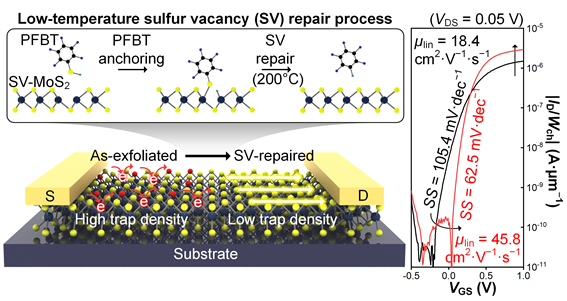UNIST 전기전자공학과 권지민 교수팀은 POSTECH 화학공학과 노용영 교수팀과 공동으로 차세대 반도체 소재인 이황화몰리브덴의 결함을 200℃에서 제거하는 기술을 개발했다.
.jpg)
▲(좌측 하단 부터 반시계방향)정학순 박사(제1저자), 권지민 교수, 이용우 박사, 홍수민 연구원, 구현호 연구원, 이상현 연구원
UNIST·POSTECH, 저온 공정으로 차세대 반도체 소재 MoS2 결함 제거
더 작고 빠른 저전력 칩을 만들 수 있는 반도체 소재의 결함을 제거하는 기술이 개발됐다.
UNIST 전기전자공학과 권지민 교수팀은 POSTECH 화학공학과 노용영 교수팀과 공동으로 차세대 반도체 소재인 이황화몰리브덴의 결함을 200℃에서 제거하는 기술을 개발했다고 25일 밝혔다.
손톱만 한 반도체 칩 하나에는 최소 수십억 개의 소자가 집적돼 있다. 이황화몰리브덴은 칩의 집적도를 높이고, 누설전류를 잡아 발열 없는 저전력 반도체 칩을 만들 수 있을 것으로 기대돼 산업계의 관심을 받는 반도체 소재다.
이황화몰리브덴을 실제 칩에 집적하는 과정에서 발생하는 결함을 저온에서 제거하는 기술은 상용화의 핵심 과제다. 이황화몰리브덴을 실리콘 소자 위에 증착하는 방식으로 활용하기 때문에, 이미 완성된 실리콘 소자가 열에 손상되면 안 되기 때문이다.
연구팀은 PFBT라는 물질로 200℃에서 결함을 메워, 이황화몰리브덴(MoS2)의 몰리브덴대 황의 원자비를 이론적 비율인 1:2에 가까운 1:1.98로 회복시켰다.
이황화몰리브덴은 박막형태로 증착되는 과정에서 황 원자가 원래 있어야 할 자리가 듬성듬성 비는 결함이 발생해 실제로는 황과 몰리브덴의 비율이 1:1.68 정도로 합성된다.
결함은 전자의 흐름을 방해하기 때문에 반도체 성능과 내구성 확보하려면 이 같은 결함을 메워 이론적 원자비에 가까운 상태로 회복시켜야만 한다.
제1 저자인 정학순 박사는 “결함 복구가 200℃ 이하에서 일어나기 때문에 기존 실리콘 반도체 BEOL 공정과도 호환이 가능하다는 것이 가장 큰 장점”이라고 설명했다.
BEOL공정은 기판에 이미 기판에 증착된 소자들을 서로 연결하는 공정으로, 소자 손상을 방지하기 위해 350℃ 이하에서 이뤄진다.
회복 단계에 사용된 PFBT(펜타플로로벤젠티올, Pentafluorobenzenethiol)는 육각형 벤젠고리에 티올작용기(-SH)와 불소(F)가 붙어있는 구조다.
티올 작용기에 포함된 황이 결함을 직접 메우고, 불소는 이 물질을 황 결함으로 유도한 뒤, 황을 제외한 물질의 나머지 부분을 쉽게 분리하는 역할을 한다.
연구팀은 분자 동역학 시뮬레이션을 통해 이 같은 화학 반응이 가능함을 확인했다. 또 X선 분광학 분석 결과, 저온에서 실제 황의 빈자리가 메워졌다.
결함이 메워진 이황화몰리브덴으로 트랜지스터 소자를 만들었을 때, 결함이 있는 경우보다 전하이동도가 2.5배 개선됐다. 전하 이동이 빠를수록 작동속도를 빠르게 할 수 있다. 소모 전력을 나타내는 지표인 ‘문턱전압 이하 스윙 값’도 40% 정도 줄었다.
권지민 교수는 “공정에서 발생하는 황 결함은 나노스케일의 첨단 노드를 겨냥한 반도체 소자에서 큰 문제이다”며 “개발한 유기 분자를 이용한 저온 황 결함 회복 기술을 통해 앞으로 이황화몰리브덴 뿐만 아니라 다양한 차세대 반도체의 소재의 결함 회복과 계면 특성 개선 연구를 더욱 확장해 나아갈 계획”이라고 밝혔다.
이번 연구는 UNIST의 정학순 박사와 POSTECH 화학공학과 김민규 연구원이 제1저자로 참여했으며, 과학기술정보통신부 한국연구재단(NRF), 정보통신기획평가원(IITP), 울산과학기술원의 지원을 받아 수행됐다.
연구결과는 나노과학기술 분야의 권위 국제학술지인 에이씨에스 나노(ACS Nano)에 2월18일 정식 출판됐다.

▲PFBT의 흡착과 탈착을 통한 저온 황 결함 회복 공정 및 전기적 성능 향상
.jpg)
